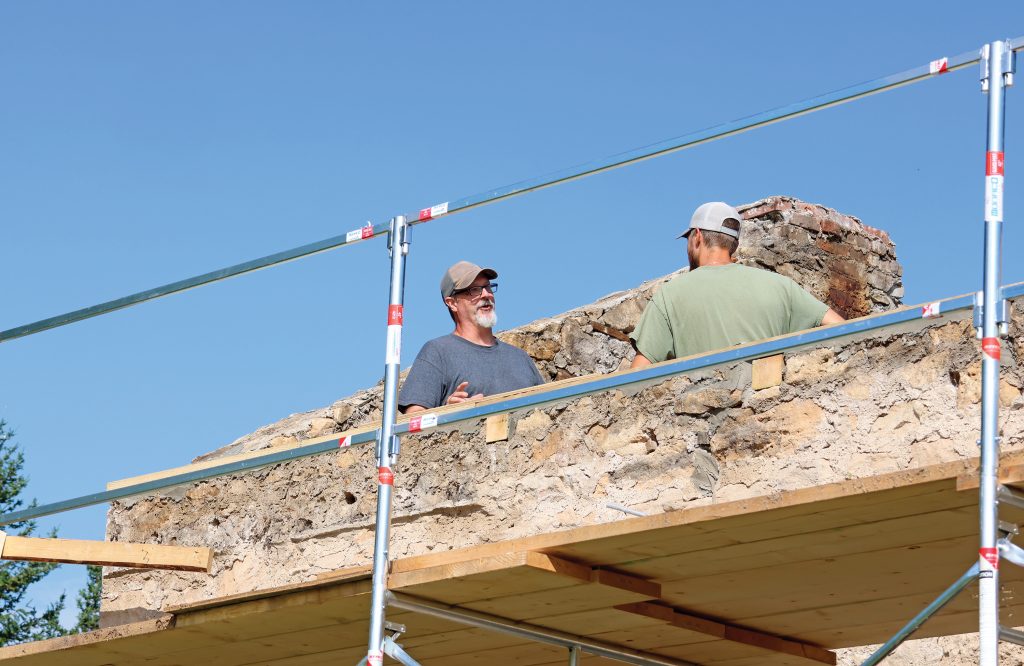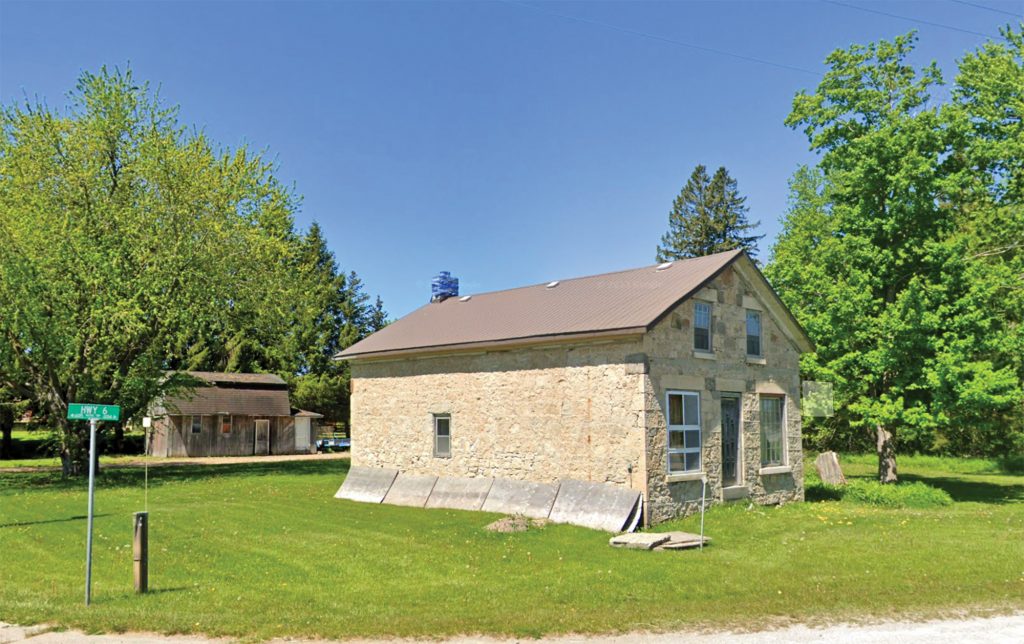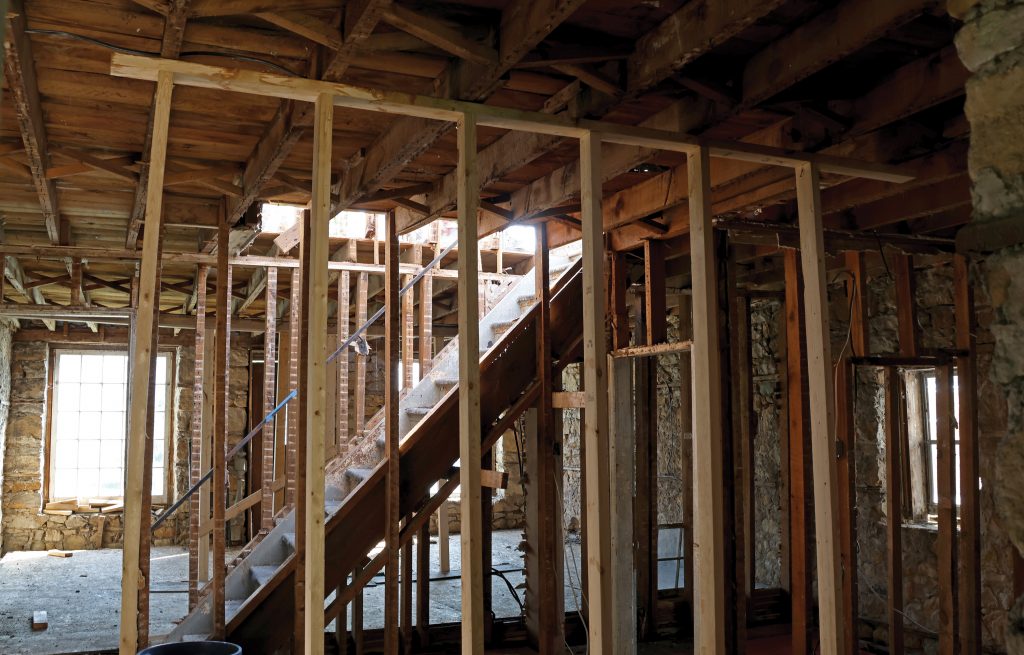ENNOTVILLE – Woodworker Steven Culumovic is not exactly sure how long the stone house at the Highway 6 intersection in Ennotville went unoccupied before he bought the property, but his estimate is 20 years.
“It was abandoned basically,” he said.
Now Culumovic is working to breathe new life into the historic building in hopes of making it his home.
“Basically, every piece of wood is coming out, and just the foundation and stone walls are staying,” he said between cutting new boards and discussing plans with framers on site.
Culumovic’s Burlington-based business Blue Skies Custom Woodwork specializes in furniture, bespoke cabinetry and architectural woodwork.
He has hired a framer and stone mason to help work on the house, but he plans to complete the finishing work himself.

Homeowner Steven Culumovic, left, talks to a worker standing on the upper level of the stone house in Ennotville where the roof had yet to be replaced on July 17. Photo by Jessica Lovell
He estimates the house to be about 180 years old, based on the limited historical information shared by a neighbour from the Ennotville Library.
The 1.5-storey stone building sits on the northwest corner of Highway 6 and 6th Line, and according to historical records, it was one of the first buildings in the hamlet.
David M. Beattie, who penned a history of Nichol Township, wrote that John McLaren erected a store and tavern in the 1840s after purchasing 15 acres from a relative, Alexander McDonald.
McLaren operated the store, and named the hamlet Ennotville “to honour a farm called Ennot near his birthplace in Scotland,” Beattie wrote.
According to a 1966 essay written by Isobel Cunningham, the building became a private residence in 1911.
Despite its connections to the history of the area, the house has no official heritage designation, nor is it listed on Centre Wellington Township’s Heritage Register.
Manager of planning services Mariana Iglesias said there is no specific reason the property is not listed.
“To add something to the register it just has to qualify by having cultural heritage value,” Iglesias said.
The Heritage Committee had been working to increase the number of properties on the local register, adding ones that had been overlooked, starting with those in the township’s urban areas, she said.
“In 2017, we added around 400 or so – in the urban centres – then we started on the rural register program,” she said.
But changes to the Heritage Act, dictating that properties must be removed from the register if they are not designated within two years of being listed, put that project on hold, she said.
Instead, the township is focusing on designating as many already-listed properties as possible.
Culumovic said he had been looking for an older building to renovate.
“It’s something I’ve always wanted to do,” he said, noting he and his wife have been renting and acting as caretakers of an 1850s stone farmhouse in Burlington for about 25 years, and they’ve developed a love of old buildings.
When they found the old Ennotville store about three years ago, it seemed like something they could work with, so they bought it.
People who regularly travel along Highway 6 may have noticed the building looking derelict in recent years, with broken glass and plywood boards in the windows.

This image, from Google Streetview, shows the home in its pre-renovation state, with windows boarded and chimney crumbling.
“It’s been sort of neglected. It needs a little bit of care,” said Culumovic.
He said when he took possession of the property, he had no key to get into the house and had to kick in the door.
“My boot was my key,” he said.
The door and pretty much all of the existing woodwork in the house were rotten, and much of it had already been gutted when the Advertiser stopped by to check out the site in mid July.
The interior staircase was still intact, but temporary framing was being used to support the second storey, while work was being done to replace the roof. Inside, the plaster was gone and the stone walls were exposed. Outside, stone and bricks that were once part of the chimney formed a pile on the lawn.

The stone is exposed in the interior of the house, which has been largely gutted. Temporary framing holds up the second floor while work is being done, but eventually all interior wood will be replaced, even the floors. Photo by Jessica Lovell
But Culumovic was optimistic about the building.
“Things look better than you might think,” he said.
Considering the age of the house, he said the stonework and foundation are in relatively good condition.
“You’ve got to have a little bit of faith in the old structures,” he said.
The property came with a couple of out buildings, one of which is a bright, clean shop where Culumovic can do the woodwork for the house. He called that space a “bonus.”
His plans don’t involve any drastic changes.
“Everything’s on the same footprint,” he said, explaining he plans to keep both the original 1.5-storey house and the single-storey addition that was put on later. The finished home will have three bedrooms and two bathrooms, and he’s hoping to be ready to move in by the end of 2025.
Culumovic said he would use his current farmhouse dwelling, which still has original interior woodwork, as a reference as he works on the house in Ennotville, keeping in mind that a general store would likely have had a more utilitarian interior.
“I will be making custom exterior doors and also window frames,” he said in an email describing his plans, noting he’s still not sure exactly what they will look like.
“We’ll make decisions as the project unfolds and the character of the building comes into clearer focus with the metal roofing on and the stonework repaired,” he said.
He hopes to replicate the 25-pane windows flanking the door that fronts onto Highway 6. Those windows were larger, possibly to display merchandise, and restoring them is a “nod to the building’s beginnings,” he said.
The building also has a cellar with exposed stone, and the remnants of some “puzzling openings” that have been filled in, he said.
“We’re enjoying trying to piece together the stories the walls can tell.”
Though progress on the project has not necessarily been quick, community members are already taking notice, with Culumovic saying he’s had positive feedback from people glad to see the house getting a little TLC.
“A guy stopped by and he said, ‘I just want to say thank you,’” he said.
Culumovic explained he plans to post about the project on his business website: blueskiescustomwoodwork.com.



